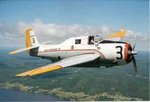How would the carrier capable dive/torpedo bomber looked like if you were in charge back then? The time frame would be the plane in service in 1940/41, and another one for 1943/44. Since the requirements for dive bomber and torpedo bomber are not always in accord, the good compromise is to be found so the plane can do both tasks. Almost forgot, the plane should be able to serve as a sub hunter, when proper electronics stuff arrives.
The championing of existing planes is discouraged
The championing of existing planes is discouraged

